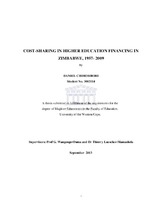| dc.description.abstract | Cost-sharing is neither a new subject nor a recent practice in the financing of students’ higher education in Zimbabwe. The practice of cost-sharing in Zimbabwe’s higher education dates back to the colonial period. Unlike those African countries that have historically had free higher education, in Zimbabwe cost-sharing has always been part of its higher education financing formulae. As a result, whereas the challenge in other African countries has been to shift from free higher education to cost-sharing, the challenge in Zimbabwe has been that of moving from one cost-sharing model to another. While Zimbabwe has experimented with various cost-sharing strategies, literature on the country’s experiences with the practice is limited. This study fills the knowledge gap by identifying and accounting for the shifts in the conception and practice of cost-sharing in the financing of students’ higher education in Zimbabwe. Consistent with the study’s focus on describing and understanding historical processes (shifts in cost-sharing policy over time) in higher education financing in Zimbabwe, a qualitative approach was adopted to gather and analyze data. In particular, the study used an historical research design to identify and account for the policy shifts in higher education financing in Zimbabwe from 1957 to 2009. The scope of the study was limited to student funding in the public university sector. The study used documents as the major sources of data, while interviews and focus group discussions with key actors in higher education financing in Zimbabwe provided additional data to validate data generated from document sources. The study demonstrates that Zimbabwe adopted cost-sharing in higher education
financing at the very point of inception of the first university in the country, the University College of Rhodesia and Nyasaland, which is now the University of Zimbabwe in 1957. Starting (in 1957) with a deferred tuition fee policy that was complemented by a mortgage type loan system and government grants, a confluence of global, national and local forces combined in specific fashion in specific historical epochs over time to ‘negotiate’ and ‘renegotiate’ the student funding models. It is further shown that during the colonial era, while the cost-sharing model rode on the back of a favourable Government loan and grant system aimed at promoting access to higher education, the racist basis of colonial education policies created bottlenecks that severely curtailed access to higher education by the majority black population. Colonial education policy iii regimes deliberately limited the feeding streams into university enrolments by black students, resulting in a proportional mismatch between the number of white students entering university and that of black students. Thus, during the colonial era, access to higher education was largely a function of the ‘barrier’ system in African education that defined inequality between whites and Africans. Independence in 1980 saw the new socialist government embracing the loan and grant based cost-sharing model and further implementing radical measures to democratize access to education. However, the increase in student numbers and in higher education institutions, coupled with poor loan recovery, and the ascendancy of neoliberalism at about the turn of the twenty-first century presented serious challenges to the state’s capacity to adequately fund higher education. In the process, the loan and grant system declined gradually and was eventually replaced by an upfront tuition fee policy that took a toll on access to higher education. Noting the inadequacies of policy interventions through the introduction of the Cadetship Scheme, the ‘successor’ to the loan and grant system, the study recommends the resuscitation of the loan system. It is however, important that such reintroduction of the loan system be predicated on the development of a robust framework that ensures that loans are allocated to students who are in
real financial need and that there is in existence, effective and efficient loan recovery machinery. | en_US |

